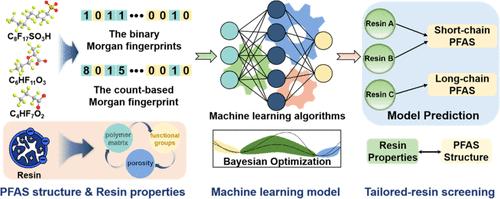数据驱动的洞察树脂筛选的目标全氟烷基和多氟烷基物质去除使用机器学习
IF 11.3
1区 环境科学与生态学
Q1 ENGINEERING, ENVIRONMENTAL
引用次数: 0
摘要
在本研究中,我们利用机器学习(ML)模型解决了筛选树脂和优化操作条件的挑战,以去除43种全氟烷基和多氟烷基物质(PFASs),跨越长链和短链氟碳变体,跨越不同的水基质。我们首先开发了ML模型,该模型可以根据树脂性质、操作条件和水基质准确预测PFASs的去除效率。通过测试集和我们自己的实验测试验证了模型的性能。全面研究了树脂性能、操作条件和水基质对PFAS去除的影响及其相互作用。我们最终以长链(如PFOS, PFOA)和短链全氟辛烷磺酸(如PFBS, GenX)为目标,使用开发的ML模型对树脂进行反向筛选,并确定在特定水基质下的最佳操作条件。实验测试表明,我们的机器学习指导方法达到了这些PFASs的预期去除效率(RE), PFBS的RE值达到86.56%,GenX的RE值达到83.73%,优于许多已报道的树脂。这项工作强调了ML方法在树脂筛选和跨不同水基质操作优化方面的潜力,能够有效去除结构不同的PFAS化合物。本文章由计算机程序翻译,如有差异,请以英文原文为准。

Data-Driven Insights into Resin Screening for Targeted Per- and Polyfluoroalkyl Substances Removal Using Machine Learning
In this study, we address the challenge of screening resins and optimizing operation conditions for the removal of 43 perfluoroalkyl and polyfluoroalkyl substances (PFASs), spanning both long- and short-chain fluorocarbon variants, across diverse water matrices, using machine learning (ML) models. We first develop ML models that can accurately predict removal efficiency of PFASs based on resin properties, operation conditions, and water matrix. The model performance is validated by using both a test set and our own experimental tests. The key features from resin properties, operation conditions, and water matrix influencing PFAS removal as well as their interaction effects are comprehensively investigated. We finally target long-chain (e.g., PFOS, PFOA) and short-chain PFASs (e.g., PFBS, GenX), using the developed ML models to inversely screen resins and determine the optimal operation conditions under a specified water matrix. Experimental tests demonstrated that our ML-guided approach achieves the desired removal efficiency (RE) for these PFASs, with RE values reaching 86.56% for PFBS and 83.73% for GenX, outperforming many reported resins. This work underscores the potential of ML methodologies in resin screening and operational optimization across diverse water matrices, enabling the efficient removal of structurally varied PFAS compounds.
求助全文
通过发布文献求助,成功后即可免费获取论文全文。
去求助
来源期刊

环境科学与技术
环境科学-工程:环境
CiteScore
17.50
自引率
9.60%
发文量
12359
审稿时长
2.8 months
期刊介绍:
Environmental Science & Technology (ES&T) is a co-sponsored academic and technical magazine by the Hubei Provincial Environmental Protection Bureau and the Hubei Provincial Academy of Environmental Sciences.
Environmental Science & Technology (ES&T) holds the status of Chinese core journals, scientific papers source journals of China, Chinese Science Citation Database source journals, and Chinese Academic Journal Comprehensive Evaluation Database source journals. This publication focuses on the academic field of environmental protection, featuring articles related to environmental protection and technical advancements.
 求助内容:
求助内容: 应助结果提醒方式:
应助结果提醒方式:


